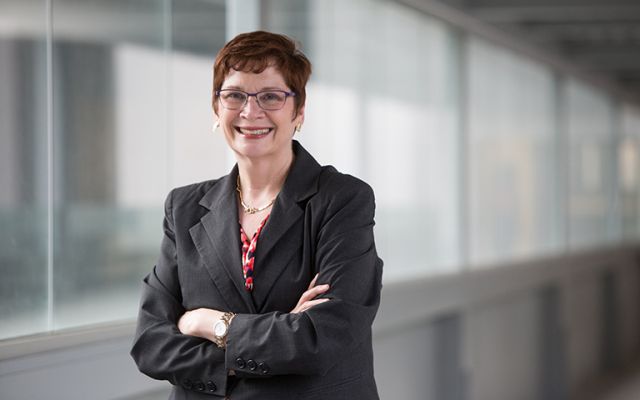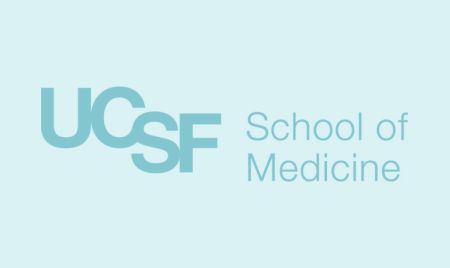Highlights from UCSF's 2018 Education Showcase: The scholarly basis for teaching and learning

Catherine Lucey, MD
May 14, 2018
“Healthcare disparities due to racially based differences in the quality of care delivered represent an invisible, silent epidemic. It’s in our wheelhouse to mobilize for this as we have for other epidemics, to educate our learners and graduates on these issues, and to collectively envision a better world where education programs and institutions are models of inclusion and equity,” said Catherine Lucey, MD, Executive Vice Dean and Vice Dean for Education during her keynote address at the annual Center for Faculty Educators Education Showcase at the Mission Bay Center and UCSF Parnassus campus in San Francisco.
Dr. Lucey’s address on equity pedagogy was among the diverse set of workshops, plenary talks and oral presentations that drew UCSF medical educators to the symposium held April 29-May 1.
The showcase illustrated the research and perspectives of faculty, learners and staff, including six plenary presentations chosen by the Haile T. Debas Academy of Medical Educators Scholarship Committee.
“On behalf of the Center for Faculty Educators, we are proud to present the 17th annual Education Showcase, an event that highlights the scholarly work in education of UCSF faculty, learners and staff,” said Ann Poncelet, PhD, Professor of Neurology and Director of the Haile T. Debas Academy of Medical Educators, UCSF Center for Faculty Educators. “Scholarly presentations address important questions and innovations in health professions education. This year we featured an impressive range of 59 mini-oral presentations which also offer opportunities for engagement and dialogue. Additionally, we hosted nine faculty development workshops chosen to address current topics in our teaching landscape,” said Patricia O’Sullivan, EdD, Director of Research and Development in Medical Education, UCSF Center for Faculty Educators.
Dr. Lucey presented the idea of ‘threshold concepts’ as a tool to guide the dialogue around healthcare disparities and to convey that mastery helps lead to greater ease in solving real-world problems. “Threshold concepts are troublesome in that they challenge current paradigms, they are integrative, and they have the potential to be transformative in the way we solve challenges around disparities in care and tackle the elements of 21st century structural racism that play out in the classrooms and clinics.”
Dr. Lucey encouraged educators to partner in redesigning educational programs to help learners from diverse racial and ethnic groups. “We must redesign learning experiences that equalize social capital for all learners, and implement assessment programs that eliminate normative- based decisions and capture the additional burdens that under-represented-in-medicine (UIM) students face. This work must be embedded in everything we do in healthcare systems and in education.”
She referenced current research (in press) in collaboration with Arianne Teherani, PhD, which showed inequities in access to career opportunities for UIM students.
If you missed the keynote address by Dr. Lucey, you can also see a presentation she delivered on this topic earlier this year at the University of Virginia.
Presentations and workshops that followed Dr. Lucey’s keynote address included:
Achieving the Ideal Ecosystem for Learning and Healthcare
- Forces that threaten our ability to learn, grow and thrive while caring for patients include time pressures, complex and stressful work, dynamic team schedules and competition for grades and prominence.
- Forces that nurture our ideal ecosystem include collaboration, teamwork, relationship building and co-ownership of all important tasks. Changes in the ways in which we work, learn, care and discover are needed to ensure that our ecosystems are thriving.
Designing Instructional Activities in the Workplace: How Cognitive Load Theory (CLT) Helps
- CLT identifies working memory limitations as a primary bottleneck for learning. When the task demands exceed working memory capacity, learning and performance suffer.
- CLT further identifies three types of cognitive load that contribute to a learner’s working memory: intrinsic, extraneous, and germane. In order to support learning and performance, educators can apply CLT to minimize extraneous load and match intrinsic and germane load to the learner’s developmental stage.
Learners in Crisis: See Something, Do Something
- Medical students are great achievers who face numerous stressors. Students arrive on our campus with rich histories, including great distances travelled, family needs, and medical / mental health treatment. Once here, there are multiple additional stressors: micro-aggressions, bias, minority tax, curricular pressures, professional development, imposter syndrome, time management, etc. Recognizing a student in crisis and using a team approach is key; crisis response often includes a range of interventions, from curricular to clinical to financial.
Using Technology for Effective Teaching
- Technology can be used to promote active learning, facilitate course evaluations, teach through simulation, enhance presentations, provide deeper exploration of content, connect faculty and learners across locations, and promote student collaboration.
Optimizing Group Decision Making for Summative Assessment of Competence
- Group decision making is increasingly common for summative assessment of learners’ competence in medical education. Clinical competency committees and grading committees are two examples of groups that review performance information and make judgments about learners’ competence and readiness to advance in training or practice.
Helping Trainees Navigate Professional Identity Tensions in the Age of Social Media
- Generational differences influence how learners and faculty use social media. Faculty can benefit from understanding current AMA and UCSF policies and best practices related to social media use and professionalism, appreciate boundary crossings and violations related to social media use, and apply privacy settings to online profiles.
Teaching Learners to Use and Find Data for QIPS
- Finding and using quality improvement and patient safety (QIPS) data can help improve health systems and patient health. In the CMC setting, students may interact with a variety of staff, faculty and other learners around QIPS data.
Learning Environments at UCSF: Creating Actionable Plans for Optimization
- Research has shown that we can influence the effectiveness of an educational experience for everyone involved by designing and maintaining the learning environment according to a set of principles.
Using Design Thinking to Advance Health and Healthcare Equity
Tuesday’s keynote address on ‘Design Thinking for Equity and Well-Being in Medical Education' included insights from medical educators Larissa Thomas, MD, Associate Professor, Jyothi Marbin, MD, Associate Clinical Professor of Pediatrics, and Rita Nguyen, MD, Assistant Clinical Professor.
Their presentations outlined the process of design thinking (including history and examples from other models), applications and relevance to medical education, as well as the potential impacts on learners participating in design thinking-based curricula.
Dr. Nguyen explained the basic concepts of design thinking, where innovation lies at the intersection of viability/usability, and feasibility. “Design thinking asks ‘what does the user need?’ and promotes purposeful learning versus skills-based learning,” she said. “When applied to healthcare, design thinking can result in improved patient experiences, decreased costs, and overall increases in population health advancements.”
Paramount to design thinking in healthcare is an A3 approach (centered on Lean principles for efficiency) that incorporates empathy for patients and their caregivers; the use of ‘low resolution’, iterative prototyping to test innovation, and; a process- versus outcome-focused methodology.
Dr. Marbin, Director of the Pediatrics Leadership for the Underserved Residency (PLUS) program, is applying design thinking to advance health equity at UCSF. “We are using this model for a human-centered, adaptive approach to create new tools to tackle complex problems and manage change,” she said. After training residents in the PLUS Program on key design thinking concepts, learners experienced persistent comfort with new concepts, deeper engagement with communities of ‘users’, and greater ease in incorporating prototyping. Dr. Marbin is also training PRIME students in design thinking and working to incorporate the model into the Bridges Curriculum.
She referenced the Better Lab, a company that applies design thinking and partners with experts at the Zuckerberg San Francisco General (ZSFG) Hospital. The aim of the joint initiative is to understand the context of healthcare challenges from different stakeholder perspectives, and develop and implement solutions that address those challenges. Projects have included redesign of the general surgery clinic at ZSFG, improved trauma rounds, and a virtual reality training program to improve trauma care at the hospital.
Dr. Thomas is using design thinking to improve physician wellbeing in residency programs at UCSF.
“We used a series of ‘empathy interviews’ to determine possible strategies that would enhance wellbeing in residency,” said Dr. Thomas. “Using ideation and prototyping, we piloted a wellness exchange where residents could access support resources for stress reduction, health and nutrition, and emotional support. We also created residency ‘families’ to increase a sense of community and support, as well as wellbeing electives whereby residents could select from mini courses to improve overall wellness.”
If you missed the keynote address on Day Three, watch the full presentation here.
Recognizing excellence in scholarship and teaching: 2018 Cooke Awards
The Academy continued its 10-year tradition in acknowledging outstanding scholarly works presented at Education Showcase. Top-scoring projects were nominated for the award following a blinded peer review of all abstract submissions.
All presentations were eligible for the Cooke Award for the Scholarship of Teaching and Learning, which recognizes outstanding scholarly works presented at the Showcase.
This year’s winners were:
- Clarice Nguyen (MS4), Professor of Medicine George Sawaya, MD, and Assistant Professor of Medicine Ari Hoffman, MD, for their work: Effect of cost exposure on medical students’ preferred mammography screening strategies: how should we teach high value care?
- Jason Parad (MS3) and Associate Professor of Medicine Denise Connor, MD, for their work: Characterizing diagnostic reasoning in the UCSF pre-clerkship curriculum








